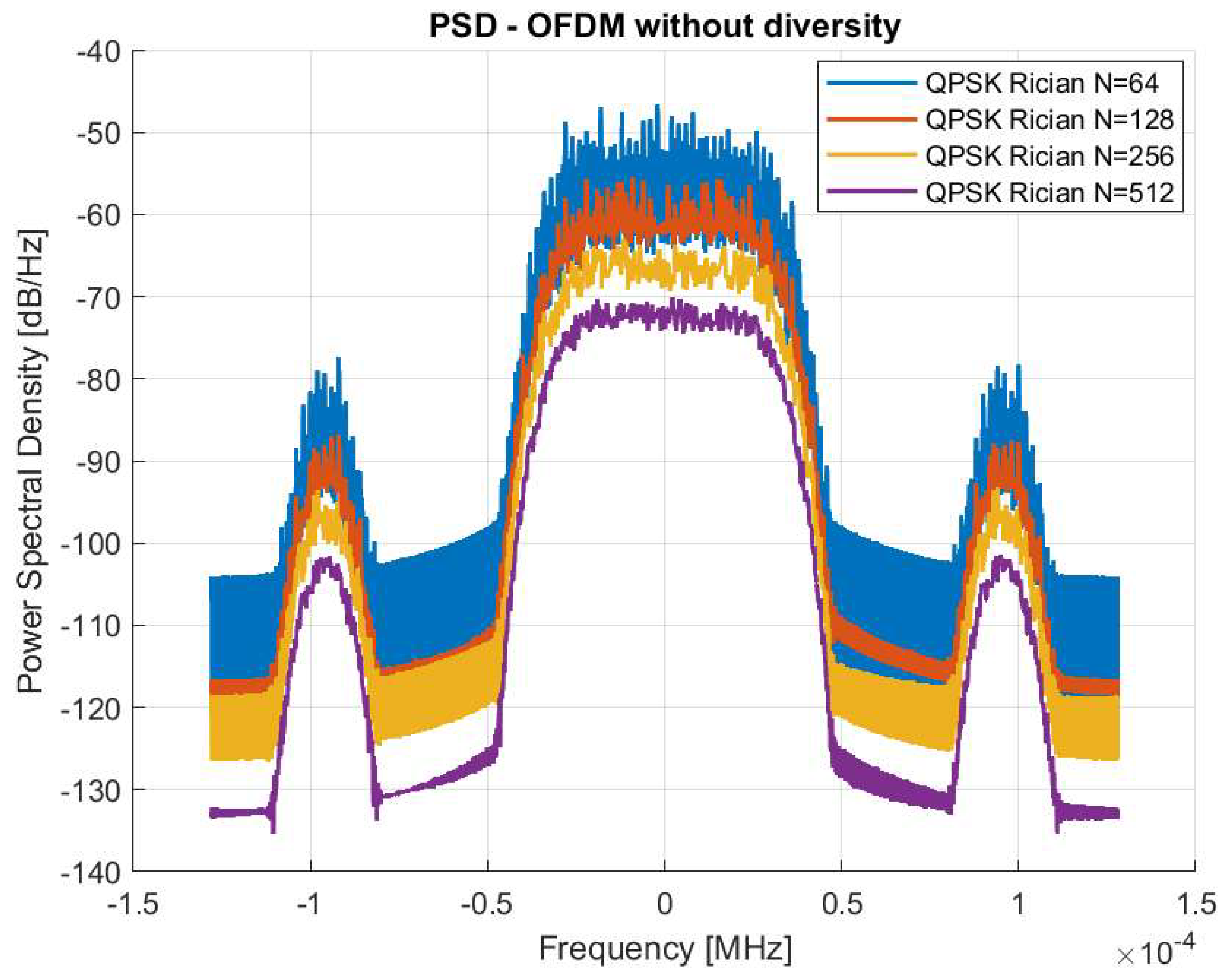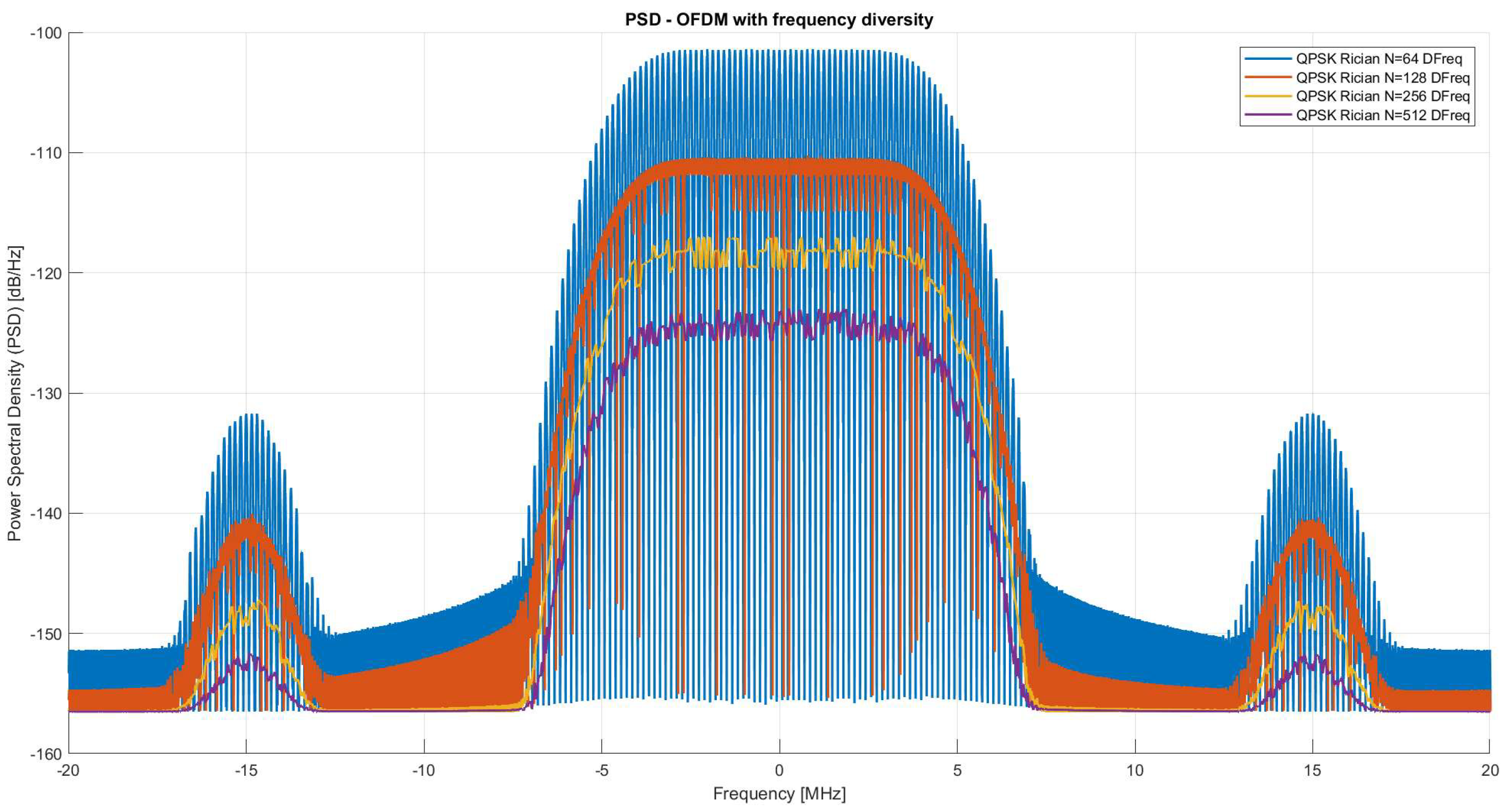Technical Guideline for Time and Frequency Diversity in OFDM Systems Under Rician Fading: MATLAB Simulation Framework †
Abstract
1. Introduction
2. Theoretical Foundations
3. OFDM System Design
3.1. General System Overview
- TX Data Generator: Random binary sequences are generated to represent the transmitted information and then the data are mapped using a digital modulation scheme such as BPSK, QPSK, 16-QAM, or 64-QAM, depending on the selected system configuration.
- OFDM Modulator: The mapped symbols are placed across orthogonal subcarrier, which are converted into the time-domain by applying an Inverse Fast Fourier Transform (IFFT). A Cyclic Prefix (CP) of configurable length is appended to each OFDM symbol to preserve orthogonality under multipath propagation.
- Channel: The signal is transmitted through either an Additive White Gaussian Noise (AWGN) channel or a Rician fading channel. For multipath environments, a configurable delay vector defines the taps and amplitudes of the channel.
- Results Presentation (BER/PSD): This block is implemented to generate and analyze the simulation results, which are presented in terms of Bit Error Rate (BER) versus Signal-to-Noise Ratio (SNR) and Power Spectral Density (PSD). Both metrics are obtained through Monte Carlo simulations, transmitting a defined number of OFDM symbols, , at each SNR level. For every point in the SNR sweep, the expected BER is estimated as the ratio of erroneously detected bits to the total number of transmitted bits, providing a statistical measure of system performance. The accuracy of this estimate depends directly on the number of simulated bits, as the total error count affects the confidence and reliability of the BER curve [12].
3.2. Configurable Parameters
3.3. Diversity Activation
4. MATLAB Implementation
4.1. Architecture and Configuration
- Waveform parameters: Number of subcarriers , cyclic prefix length , and modulation order {BPSK, QPSK, 16-QAM, 64-QAM}.
- Channel configuration: AWGN, Rician, or combined models, with path delays, tap gains, -factor, and optional Doppler spread. The Rician model supports manual convolution or MATLAB’s comm.RicianChannel object.
- SNR range: Defined as dB, evaluated across 10,000 Monte Carlo iterations per point.
- Diversity control: Flags ‘diversidad_activa’ and ‘diversidad_frecuencia’ activate time and frequency diversity, respectively.
- Validation: Ensures ≥ maximum delay spread to avoid ISI.
4.2. Processing Blocks
- Bit Generator (generate_bits.m) Produces random binary sequences per frame.
- Modulator (modulator.m): Maps bits to constellation symbols.
- Diversity Mapper (map_freq_diversity.m):
- Time diversity: Repeats symbols across independent OFDM time slots.
- Frequency diversity: Interleaves replicas across distant subcarriers.
- IFFT (apply_ifft.m): Converts symbols to the time domain.
- Cyclic Prefix (add_cp.m, remove_cp.m): Manages insertion and removal of .
- Channel (channel_tx.m): Adds Rician multipath fading and AWGN.
- FFT (apply_fft.m): Recovers symbols in the frequency domain.
- Combiner (combine_mrc.m): Applies Maximum Ratio Combining (MRC) using ideal channel knowledge.
- Demodulator (demodulator.m): Estimates the bitstream from received symbols.
- BER Computation (compute_BER.m): Compares transmitted and received bits across all trials.
- PSD Estimation (plot_psd.m): Evaluates the power spectral density before the channel.
4.3. Diversity Implementation
5. Results and Discussion
5.1. BER Analysis: Frequency Diversity
5.2. Power Spectral Density (PSD) Analysis
- For , the PSD shows more spectral leakage and sharper transitions, indicating lower frequency resolution [10].
- As N increases, the PSD becomes progressively narrower and smoother, evidencing improved spectral confinement and resolution.
- The symmetry around the center frequency is preserved, and the energy remains concentrated in the main lobe, confirming that the spectral efficiency is not severely affected.
6. Conclusions
Author Contributions
Funding
Institutional Review Board Statement
Informed Consent Statement
Data Availability Statement
Acknowledgments
Conflicts of Interest
Abbreviations
| AWGN | Additive White Gaussian Noise |
| BER | Bit Error Rate |
| CP | Cyclic Prefix |
| FFT | Fast Fourier Transform |
| IFFT | Inverse Fast Fourier Transform |
| LOS | Line of Sight |
| MRC | Maximum Ratio Combining |
| NLOS | Non Line of Sight |
| OFDM | Orthogonal Frequency Division Multiplexing |
| PSD | Power Spectral Density |
| QAM | Quadrature Amplitude Modulation |
| QPSK | Quadrature Phase Shift Keying |
| SNR | Signal-to-Noise Ratio |
References
- Jiménez, V.M. Performance of IEEE 802.11a Physical Layer in Multipath Fading Channels; University of Sevilla: Sevilla, Spain, 2004. [Google Scholar]
- Carrillo, S. Simulación de Sistemas de Comunicaciones Móviles E Inalámbricas. Master’s Thesis, Universidad Politécnica de Madrid, Madrid, Spain, 2001. [Google Scholar]
- Ahmed, A.; Siddqui, A.; Khan, R.; Nabi, G.; Ali, M. Comparative analysis of OFDM in AWGN & Local Acoustic Channel. In Proceedings of the 2024 IEEE 1st Karachi Section Humanitarian Technology Conference (KHI-HTC), Tandojam, Pakistan, 8–9 January 2024; pp. 1–4. [Google Scholar] [CrossRef]
- Van Nee, R.; Prasad, R. OFDM for Wireless Multimedia Communications; Artech House: Boston, MA, USA, 2000. [Google Scholar]
- Tse, D.; Viswanath, P. Fundamentals of Wireless Communication; Cambridge University Press: Cambridge, UK, 2005. [Google Scholar]
- Chaudhari, Q. Diversity in Wireless Communication Systems. Wireless Pi, 2020. Available online: https://wirelesspi.com/diversity-in-wireless-communication-systems/ (accessed on 9 August 2025).
- Barcelona, U.P. Modelado de Canal—Características de Canales Inalámbricos; Apuntes: Mexico City, Mexico, 2018. [Google Scholar]
- Prasad, R. OFDM for Wireless Communication Systems, Volume 2, Artech House Universal Personal Communications Series; Artech House: Boston, MA, USA, 2004; pp. 1–272. ISBN 978-1-58053-799-5. [Google Scholar]
- Hanzo, L.; Münster, M.; Choi, B.J.; Keller, T. OFDM and MC-CDMA for Broadband Multi-User Communications, WLANs and Broadcasting. John Wiley & Sons: Hoboken, NJ, USA, 2003. [Google Scholar]
- Li, Y.; Stüber, G.L. Orthogonal Frequency Division Multiplexing for Wireless Communications; Springer: Berlin/Heidelberg, Germany, 2006. [Google Scholar]
- Rappaport, T.S. Wireless Communications: Principles and Practice, 2nd ed.; Prentice Hall: Hoboken, NJ, USA, 2002. [Google Scholar]
- Proakis, J.G.; Salehi, M. Digital Communications, 5th ed.; McGraw-Hill: New York, NY, USA, 2008. [Google Scholar]
- Haykin, S.; Moher, M. Modern Wireless Communications; Pearson Education: London, UK, 2005. [Google Scholar]
- Goldsmith, A. Wireless Communications; Cambridge University Press: Cambridge, UK, 2005. [Google Scholar]
- Sklar, B. Rayleigh fading channels in mobile digital communication systems. I. Characterization. IEEE Commun. Mag. 1997, 35, 90–100. [Google Scholar] [CrossRef]
- Rohling, H. OFDM: Concepts for Future Communication Systems; Rohling, H., Ed.; Springer: Berlin/Heidelberg, Germany, 2011. [Google Scholar]






Disclaimer/Publisher’s Note: The statements, opinions and data contained in all publications are solely those of the individual author(s) and contributor(s) and not of MDPI and/or the editor(s). MDPI and/or the editor(s) disclaim responsibility for any injury to people or property resulting from any ideas, methods, instructions or products referred to in the content. |
© 2025 by the authors. Licensee MDPI, Basel, Switzerland. This article is an open access article distributed under the terms and conditions of the Creative Commons Attribution (CC BY) license (https://creativecommons.org/licenses/by/4.0/).
Share and Cite
Cacuango-Collaguazo, C.; Ortiz-Fiscal, M.; Paredes-Paredes, M.C. Technical Guideline for Time and Frequency Diversity in OFDM Systems Under Rician Fading: MATLAB Simulation Framework. Eng. Proc. 2025, 115, 19. https://doi.org/10.3390/engproc2025115019
Cacuango-Collaguazo C, Ortiz-Fiscal M, Paredes-Paredes MC. Technical Guideline for Time and Frequency Diversity in OFDM Systems Under Rician Fading: MATLAB Simulation Framework. Engineering Proceedings. 2025; 115(1):19. https://doi.org/10.3390/engproc2025115019
Chicago/Turabian StyleCacuango-Collaguazo, Carlos, Micaela Ortiz-Fiscal, and Martha Cecilia Paredes-Paredes. 2025. "Technical Guideline for Time and Frequency Diversity in OFDM Systems Under Rician Fading: MATLAB Simulation Framework" Engineering Proceedings 115, no. 1: 19. https://doi.org/10.3390/engproc2025115019
APA StyleCacuango-Collaguazo, C., Ortiz-Fiscal, M., & Paredes-Paredes, M. C. (2025). Technical Guideline for Time and Frequency Diversity in OFDM Systems Under Rician Fading: MATLAB Simulation Framework. Engineering Proceedings, 115(1), 19. https://doi.org/10.3390/engproc2025115019




